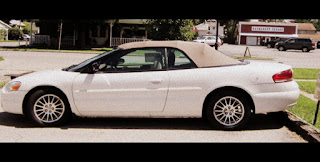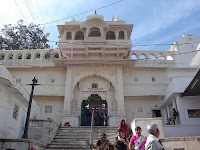"Francis' handling of tradition and modernity privileges neither, but rather produces a workable synthesis of their contributions."
Elizabeth Stoker Bruenig, "Francis Agonistes," The New Republic, March/April 2015
 |
Illustration, Steve Brodner,
"Francis Agonistes,"New Republic. |
It seems that my brother Loren went with me to hear Fr. Jim Bacik talk about the Pope's new Encyclical on the Environment and Climate Change. These were issues dear to Loren's heart, and wherever he is now, I know they still are. That's why I'm sure Loren feels kindly toward this son of Italian immigrants to Argentina who took the name Francis, after a saint who worshipped nature and all creation.
I knew this Pope would be different when he took that name. Fr. Bacik says the same thing. The first Pope named Francis. Also, the first Pope from South America and maybe the first to work for so long among the poor, in the slums of Buenos Aries, that sprawling capital city that straddles urbanity and a prehistoric and Spanish colonial past, cultural diversity and artistic creativity, political complexity and economic disparity. One can't be steeped in and shaped by such a dramatic culture and not develop a distinctive way of looking at the world.
And so Francis brings to the papacy a unique
Weltunsheung, in the fullest meaning of that loaded and nuanced German word. Literally, a different worldview. He sees the world through a different lens than his predecessors. Some fear it; some welcome it.
A natural leader, accessible as well as formidable, compassionate as well as politically savvy, Pope Francis forges ahead where angels fear to tread, as Fr. Bacik noted with both gratitude and amusement. His pronouncements, on inequality, materialism, unregulated capitalism, and now climate change, upset conservative Catholics, politicians and pundits, and raise hope among social justice workers, the poor, progressive thinkers. His answer to a question about homosexuality, "Who am I to judge?" encompasses this volatile spectrum.
Not that the Pope is changing Catholic doctrine. He's not John XXIII. "It seems rather that Francis inspires uncomfortable feelings, and affronts particular dispositions rather than particular doctrine," said Elizabeth Stoker Bruenig in her brilliant
New Republic article "Francis Agonistes." Pope Francis stands on the border of tradition and modernity, "privileging neither," honoring both, urging us to explore and consider a broader view of the world.

Fr. Bacik, in explicating the content and purpose of the environmental encyclical, affirmed that view. Francis' mission is to encourage discussion and promote new ways of thinking about hot-button issues. He is fearless and assured, wrapped in the cloak of St. Francis himself and the traditions of the Church, unruffled by criticism and anxiety.
My own take on this is similar, informed by my brother Loren's unique worldview. The Pope understands that change takes place from the bottom up. He knows this through his experiences in working in urban slums, imbibing the spirit of Liberation theology, developing an economic and political analysis of causes and consequences. He understands that change begins with the needs of the people, ordinary people, the disenfranchised, and that it becomes institutionalized and enforced from the top down
only if you educate and change public opinion.
Yes! This is what Francis wants to do, Fr. Bacik said: educate, enlighten, probe and prod. "It's his passion," to open up the way we look at and address critical contemporary issues, which he knows first-hand and sees as interrelated. This encyclical on the multi-dimensional crisis of climate change caused by human activities advances this mission. It's the first encyclical devoted entirely to ecology.
Wow, I thought. My brother Loren, the compassionate ecologist who talked endlessly about saving Mother Earth, must be celebrating with like-minded spirits somewhere. Some say that would be in heaven, which I want to believe, but I'm not sure where he is.
I know Loren lived this philosophy, and took it to a higher level. He saw, with insight informed by extensive reading and study, including a Master's degree in Social Ecology, and a mind wired for nontraditional perspectives, that we had to address these problems in order to get to the fundamental cause of them all: the dominance of Patriarchy and patriarchal thinking in the material world.
Someone in the audience, a former co-pastor with Fr. Bacik at Corpus Christi church it turned out, actually raised the issue, to my amazement. It jolted me. Good heavens, Loren is in this room!
"The Pope's not ready to take this on," Fr. Bacik smiled, as if anticipating this question from this colleaque, who I immediately felt was my brother incarnate.
"Pope's on the right path," I thought I heard Loren reply. He's laying the groundwork needed to unpeel the layers of age-old myths and conditioned belief systems that cover up the issue at the heart of the matter. The Pope is close to this truth, stifled over the generations, that there is a goddess as well as a god who oversees our world, a feminine holy spirit that softens the harshness of patriarchy, that respects the very source of life itself, the Mother, the Giver, the Healer. "If there is a God, then there must be a Goddess," Loren would argue in the face of daunting disbelief. Actually, he went further than that, envisioning God as the Goddess, the Goddess as God, God and Goddess as one.
 |
From the Encyclical: Eco-spirituality
joins care for the material world and the poor. |
"Well, let it be," Loren muses, now more attuned to cosmic than earthly time. It's a good start to acknowledge that we have inflicted harm on Mother Earth, disrespected and denigrated her, and that we need to come together and do something about it. The Pope recognizes that we are part of "a universal communion in which everything is connected." It's the wisdom of Chief Seneca, the worldview of America's indigenous peoples in their relationship with nature. "And a
universal communion that
includes a goddess spirituality, a feminine holy voice," Loren adds.
 |
Eco-spirituality honors the common good. All
creatures are interconnected and must be cherished.. |
Fr. Bacik's voice breaks through these reflections. The pope in his encyclical urges us to see beyond the "technocratic paradigm" that blinds us to a more "ecological spirituality." He urges us to move beyond materialistic and utilitarian views of the world that focus on profit, consumerism, and greed. The "eco-paradigm" that Francis puts forth respects our natural world, cares for the earth and its inhabitants, offers paths to growth, human development, and social justice.
"Yes, so close, so close." Loren interjects. Just a little tweaking here and there. The Pope could, for example, substitute the broader term "patriarchal paradigm" for his use of the term "technocratic paradigm." Instead of using the term "ecological spirituality," he could talk about "goddess spirituality."
It's the same thing. Maybe he doesn't know it; maybe he doesn't believe it. But if he took his own advice, opened his mind to a different point of view, he would see it.
"Now that, my friends, would signify a real revolution in consciousness and human relations, and save our planet!" Such a revolution would move the entire world, our whole precious planet, toward tenderness, mercy and harmony, toward peace and justice, toward mothering all God's children and every creature on earth, toward saving what truly is our "Common Home."
One of the Francis agonistes quoted in Bruenig's article, Steve Moore, chief economist at The Heritage Foundation, accuses Francis of being an adherent of a "modern pagan green religion." Loren smiles, nods. "Moore is on to something!"
 |
| Remembering Loren: Being with Loren, his autobiography, our grief, our memorial. |










































